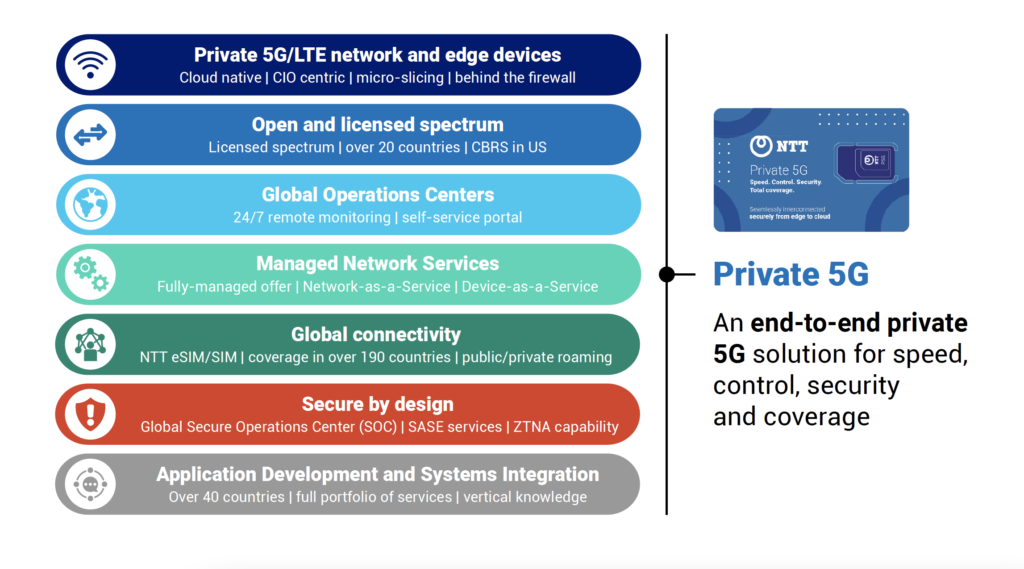NTT: Biggest challenges to effectively integrate private 5G into existing infrastructure and applications?
by Shahid Ahmed of NTT
Introduction:
For most countries, the public 5G networks are expected to enable users to experience a whole new level of connectivity. Enterprises are wanting to make the most of the network as well. While the public 5G networks do offer enterprise solutions and services, a private 5G network might just be the better option for them.

Why should enterprises consider a private 5G network?

Shahid Ahmed, Group EVP, New Ventures and Innovation at NTT Ltd.
…………………………………………………………………………………………………………………………….
As enterprises continue supporting wider digitization, the demands on secure and reliable connectivity solutions are increasing. NTT recently partnered with the Economist Impact and interviewed over 200 CIOs globally, and our findings show they expect to benefit from the improved data control, privacy, and security as the most anticipated outcomes of implementing private 5G networks followed closely by improving workforce productivity through automation.
Advanced connectivity is an essential element for industrial automation applications in manufacturing facilities, Automotive, Hospitals, and Warehousing Facilities. Hence, private 5G networks provide a single network for mission-critical operational technology (OT) using micro-slicing to support manufacturing workflow automation, autonomous guided robots, and machine vision AI applications.
For most industrial applications, the cost of ownership for private 5G wireless is better than alternative technologies operating in an unlicensed spectrum. The TCO of private 5G wireless networks is lower (when compared to WiFi) because these networks provide wider (especially outdoor) coverage requiring far fewer access points which means less overall infrastructure to install and manage.
What are the biggest challenges when it comes to effectively integrating private 5G into existing infrastructure and applications?
Through NTT’s recently conducted CIO survey alongside secondary research, our findings revealed that the most common (44%) barrier to deploying private 5G networks is integrating the technology with legacy systems and networks. The complexity surrounding the deployment and management of private 5G networks was also cited as another significant barrier by 37% of respondents given that 5G technology is still in the early stages of its adoption lifecycle. Employees lacking the technical skills and expertise to manage 5G networks was the third most common barrier facing 30% of firms.
In view of these challenges, organizations could consider outsourcing their private 5G deployment to a managed service provider who will have the expertise when it comes to implementing private 5G networks. This is likely to be the most common approach to private 5G adoption, preferred by 38% of survey respondents. Buying a private 5G network ‘as-a-service’ can accelerate the adoption process and offer a better end-user experience and return on investment for companies.
Additionally, it is important to integrate the private 5G network into business operational workflows. For example, in cases such as safety and maintenance, these business processes and employee and machine workflows must be directly integrated into the network.

Source – NTT
………………………………………………………………………………………………………………………
How is NTT helping enterprises with their private 5G adoption? Are there any use case examples to share?
We have a range of commercial out of the box use cases and device solutions available; for example, autonomous guided robots, machine vision worker safety PPE detection, machine vision AI smart factory and smart building solutions, group communication Push to Talk (PTT), AR/VR connected workforce, and automate manufacturing workflow solutions. These are just some examples of use cases NTT has curated internally or together with our partners.
NTT’s private 5G (P5G) fully managed Network as a Service (NaaS) solution is ideally suited for enterprises in need of better security, data management, and privacy supporting their wider enterprise digitization initiatives. NTT further provides system design and integration services to integrate the network existing systems and application and network management upon completion of the network. The solution is pre-integrated with leading network suppliers, offering clients the flexibility to seamlessly work with any industry-certified applications.
When it comes to cybersecurity, will private 5G enable enterprises to have better visibility and control over their network?
Security is the main draw for enterprises when it comes to private 5G adoption. This was also one of the key findings from the Economist Impact survey with 83% of executives citing it as the number one reason why they wanted to build a private 5G network.
Private 5G enabled networks are built around Zero Trust (ZTNA) principles leveraging SIM-based (multi-factor) authentication and authorization, enhanced end-user data encryption, enhanced authentication, and data encryption between network sub-components and network slicing.
Together, these enhancements provide end-to-end security and strict access control, through device authentication and protecting sensitive data with network isolation. It enables true granular micro[1]slicing capabilities where traffic within the facilities and warehouses can be segmented according to enterprise IT/OT SLA needs.
Lastly, the 5G network has been making headlines in the US over concerns it can affect aircraft radar. Should businesses be concerned if a private 5G network might affect other machinery in their plants?
With regards to concerns relating to 5G networks affecting aircraft radar, discussion among wireless carriers as well as the airline industry and regulators are still ongoing, and it is too early to speculate on the way forward.
Private 5G networks in the US are different than Public 5G. Additionally, most private networks in the US will leverage the CBRS band which is an FCC-approved and shared band, much further removed from the frequencies used for aviation altimeters systems while operating at much lower power than public 5G networks.
Similarly, the risks of deploying private 5G to an organization’s machinery is unlikely – and because the networks are custom, the individual network can be configured properly so there is ZERO RISK. Companies may benefit from leveraging a managed service provider who will be able to manage the infrastructure, implementation process, and any ongoing operational risks.
References:
https://techwireasia.com/2022/02/enabling-more-enterprise-use-cases-with-private-5g-networks/
One thought on “NTT: Biggest challenges to effectively integrate private 5G into existing infrastructure and applications?”
Comments are closed.


Hughes Network Systems announced the award of an $18 million contract from the Department of Defense (DoD) to deploy a standalone 5G network at Naval Air Station Whidbey Island in Washington state. The Other Transaction Agreement (OTA) was issued through the Information Warfare Research Project (IWRP) consortium, a collaboration to engage industry and academia to develop and mature technologies in the field of information warfare that enhance Navy and Marine Corps mission effectiveness. Hughes will serve as the prime contractor connecting the base with a secure 5G network to support operations, maintenance and flight traffic management. The Hughes 5G network will utilize spectrum from DISH Wireless, the only carrier capable of providing the right combination of low band, mid band, and high band (mmWave) spectrum. This work is part of on-going DoD 5G experimentation led by the Under Secretary of Defense for Research and Engineering at Joint Base Pearl Harbor-Hickam.
“Over the course of this three-year project, we will demonstrate for the U.S. Department of Defense how 5G infrastructure from Hughes – including a packet processing core, radio access, edge cloud, security and network management – can power the resilient networking necessary to transform base operations,” said Dr. Rajeev Gopal, vice president, Advanced Programs, Hughes. “Today’s walkie-talkies, paper-trails and telephone conversations will be replaced with a private, secure 5G network over which air station processes and systems will be automated and continuously optimized. What’s more, the standalone, standards-based configuration – including O-RAN standards for flexibility – will connect seamlessly anywhere on the planet using Low Earth Orbit (LEO) and Geostationary Orbit (GEO) satellite connectivity.”
“DISH is delivering the connectivity for this private 5G network, providing engineering services, support and access to our spectrum portfolio,” said Stephen Bye, chief commercial officer, DISH. “As we build our own network, we’re proud to team with Hughes in this important project to deliver a fast, secure, reliable network to serve the U.S. Department of Defense and support mission-critical functions.”
“This award is a testament to Hughes leadership in engineering and managing smart networks that enable the military to exchange information with the right people at the right time with an any-network approach that’s hardware agnostic and transport independent,” said Rick Lober, vice president and general manager, Hughes Defense. “We look forward to showcasing our capabilities in secure management of a 5G stand-alone deployment with advanced artificial intelligence and machine learning for ongoing enhancement and increasing efficiencies.”
The deployment, which began in September 2021, leverages Zero Trust Architecture (ZTA) and meets National Security Administration (NSA) Commercial Solution for Classified (CSFC) requirements. Working together on the project, with Hughes as the integrator, are: Boingo Wireless, Cisco, Dell, DISH, JMA Wireless and Intel.
https://www.prnewswire.com/news-releases/hughes-selected-to-deploy-private-5g-network-for-dod-301505964.html